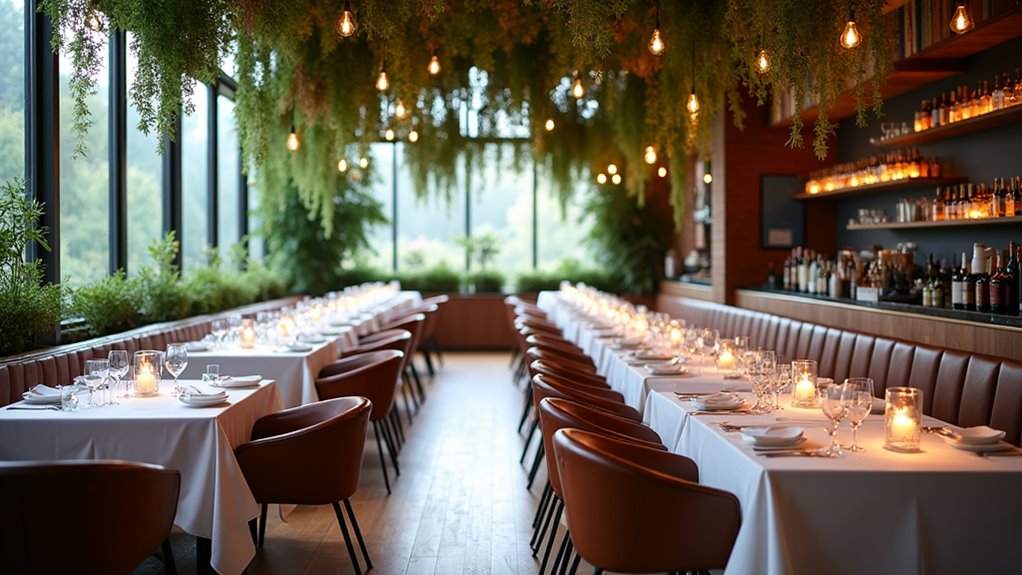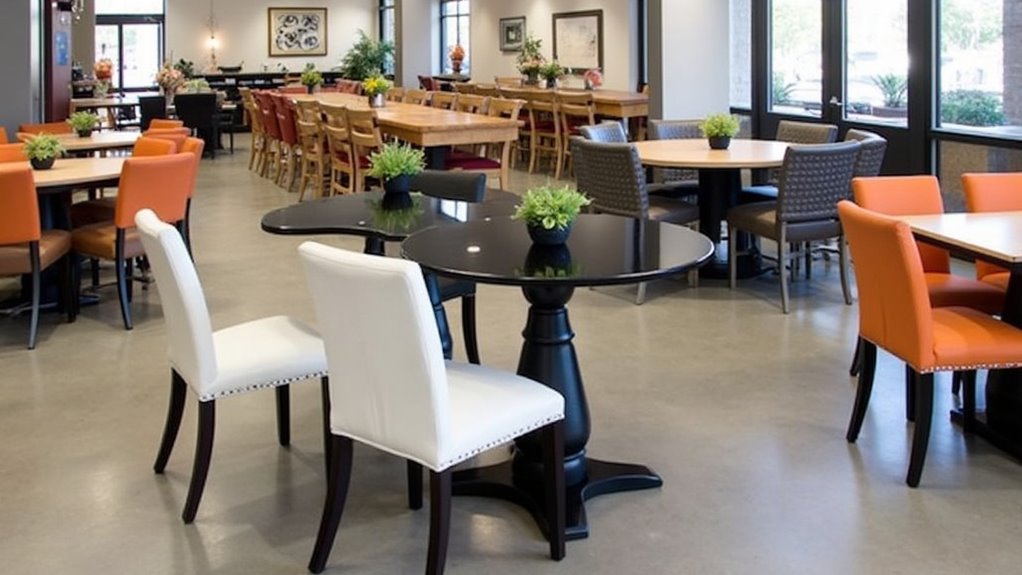A restaurant with 26 tables effectively manages its dining room by utilizing flexible layouts and innovative space utilization. Varied table sizes accommodate different group dynamics, while advanced reservation systems minimize no-shows and enhance customer experience. Staff training focuses on efficiency and operational feasibility, ensuring smooth service. Additionally, real-time occupancy monitoring optimizes table arrangements while maintaining safety and comfort. This strategic approach fosters an inviting dining atmosphere, creating a seamless experience for guests, with more insights available ahead.
Key Takeaways
- The restaurant employs flexible table layouts to adapt to various group sizes, ensuring optimal space utilization and guest comfort.
- Advanced reservation software helps manage real-time bookings, minimizing double bookings and enhancing customer experience.
- A streamlined menu with limited options accelerates decision-making for diners while ensuring operational efficiency.
- Staff undergo structured training programs, focusing on role-specific skills and continuous feedback for improved service quality.
- Real-time occupancy monitoring and modular furniture enable quick adjustments to dining arrangements, maintaining safety and space efficiency.
Flexible Table Layout and Seating Strategies

A restaurant’s success often hinges on its ability to adapt its dining room layout to various guest needs, enhancing both capacity and comfort. Flexible table layouts employing varied sizes and shapes allow for effective space optimization, accommodating parties ranging from intimate two-tops to larger four-tops. Seasonal adjustments ensure that guest flow aligns with demand patterns, allowing staff to navigate easily while minimizing congestion. Additionally, effective space utilization through strategic seating arrangements ensures maximum efficiency in seating arrangements while accommodating diverse group sizes. Round extendable dining tables often present a practical solution to this challenge, as they can expand to accommodate additional guests as needed while maintaining a comfortable dining experience. Prioritizing accessibility for guests with mobility challenges is crucial for maintaining an inclusive atmosphere.
Adequate spacing between tables promotes comfort while maintaining operational efficiency. Zoning the dining area enhances the customer experience, creating distinct service corridors and areas for different activities. Additionally, utilizing modular tables allows for rapid configuration changes, fostering a dynamic environment that fulfills diverse customer requirements and maximizes seating potential without compromising safety or accessibility.
Reservation and Booking Optimization Techniques
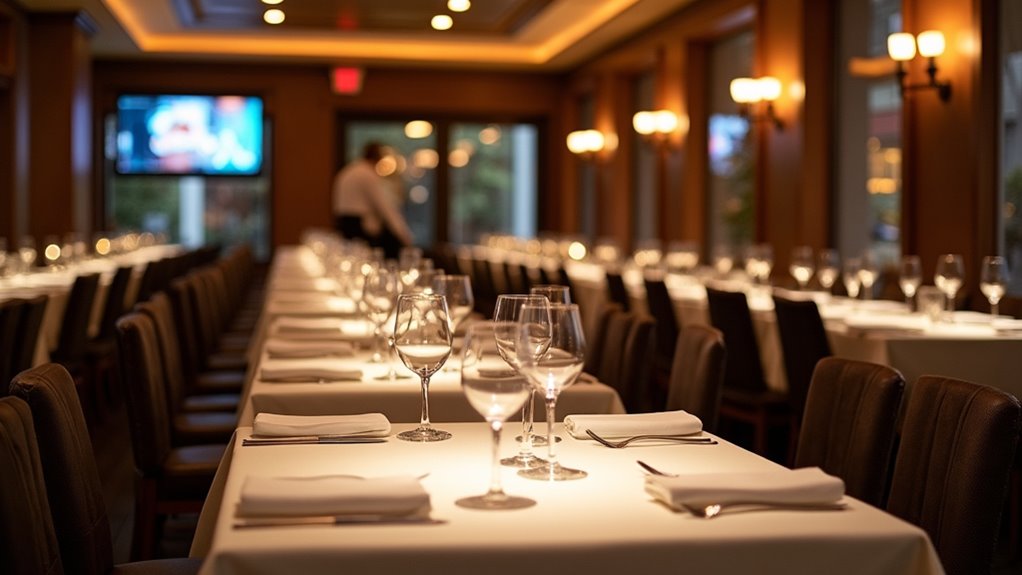
Effective reservation and booking optimization techniques can significantly enhance a restaurant’s operational efficiency and guest satisfaction. By utilizing advanced reservation software, restaurants can implement real-time integration across multiple platforms, preventing double bookings and improving table availability. Automated reminders reduce no-show rates, while customer data analytics facilitate personalized booking experiences.
| Technique | Benefit | Key Feature |
|---|---|---|
| Real-Time Integration | Seamless guest management | Prevents double bookings |
| Automated Confirmation | Reduces no-show rates | SMS and email reminders |
| Customer Data Utilization | Tailored dining experiences | Captures guest profiles |
Enhancing Staff Training and Workflow Efficiency
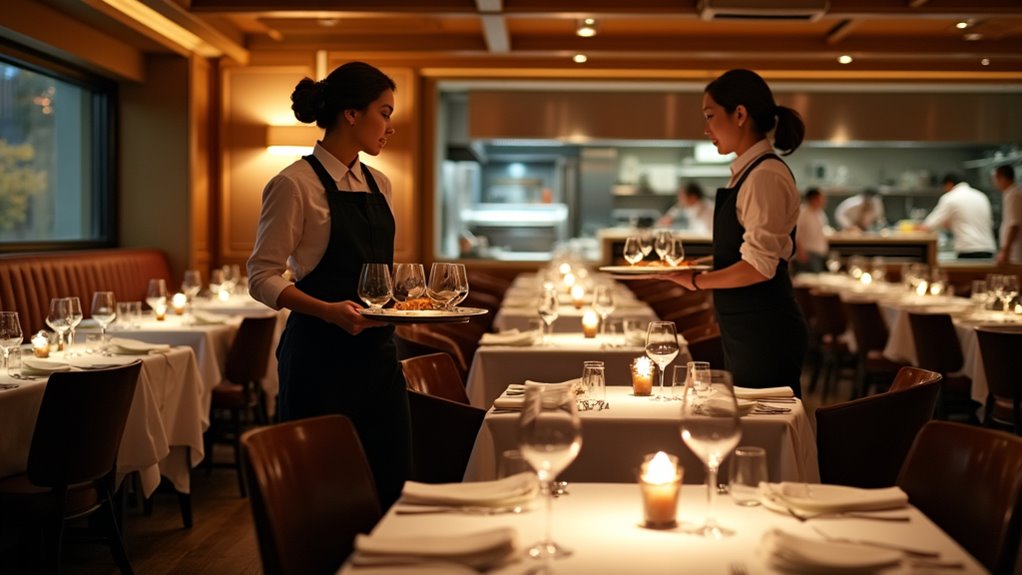
Optimizing reservation systems serves as a foundation for enhancing overall restaurant operations, leading naturally to a focus on staff training and workflow efficiency.
Structured training programs ensure all employees are familiar with policies and safety while role-specific modules empower staff with necessary skills. Peer mentoring facilitates hands-on learning, with experienced employees guiding new hires through shadowing sessions. This approach nurtures collaboration and strengthens team dynamics.
Continuous feedback during shifts allows managers to address performance issues in real-time, balancing constructive criticism with positive reinforcement. Incorporating technology, such as mobile training platforms and gamification, keeps staff engaged while standardized training materials ensure consistency.
Ultimately, these initiatives create a well-trained team capable of delivering exceptional customer service efficiently.
Maximizing Capacity While Ensuring Safety and Comfort
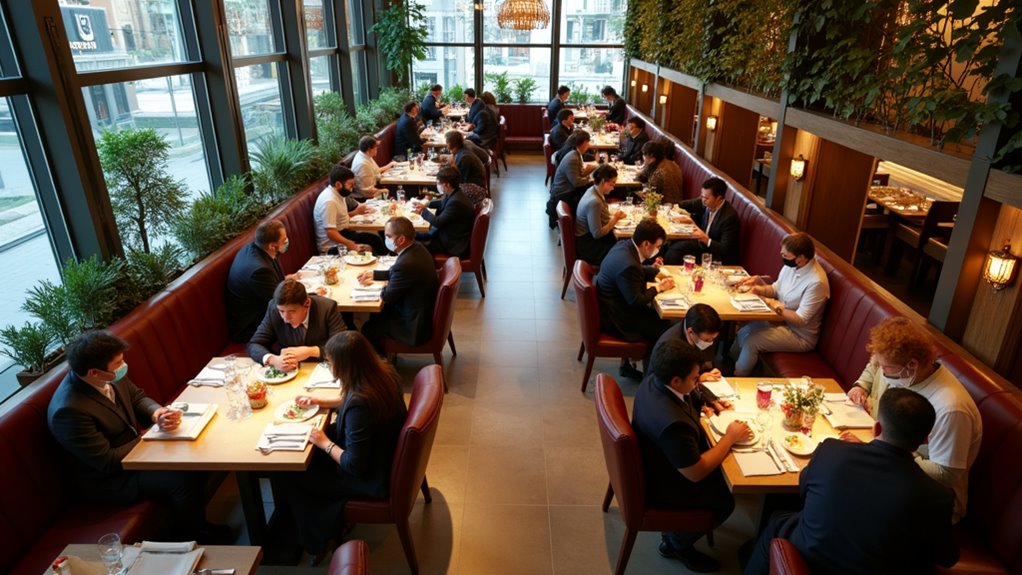
To maximize capacity while ensuring safety and comfort, restaurants can implement flexible seating configurations that accommodate various group sizes without crowding.
Incorporating real-time occupancy monitoring helps track table usage and optimize seating arrangements, enhancing guest flow.
Additionally, safety measures such as adequate table spacing and modular furniture contribute to a pleasant dining environment while adhering to regulations. Restaurants can also consider using solid hardwood dining tables for their durability and unique designs, which can enhance the overall aesthetic and functionality of the space.
Flexible Seating Configurations
A well-designed dining room can significantly enhance a restaurant’s capacity while prioritizing guest safety and comfort. Flexible seating configurations featuring seating diversity are key to achieving this goal.
By integrating a mix of booths, banquettes, communal tables, and movable chairs, restaurants can accommodate various group sizes and preferences efficiently. Smaller tables can be combined for larger gatherings, showcasing layout adaptability while optimizing space.
Additionally, modular and lightweight furniture facilitates quick reconfigurations in response to customer flow. Prioritizing a balance between maximizing seating and ensuring comfort is essential, as adequate spacing can enhance the overall dining experience.
This thoughtful approach allows restaurants to respond effectively to changing demands without compromising on ambiance or guest privacy.
Safety Measures Implemented
While maintaining a thriving dining environment, restaurant management places a strong emphasis on implementing safety measures that prioritize the well-being of both guests and staff.
The restaurant enforces rigorous sanitation protocols, ensuring that tables, menus, and payment terminals are disinfected after each use. Employees are required to wear masks and gloves at all times, and symptomatic staff must remain home to protect employee wellness and prevent exposure.
Cleaning schedules are vigilant, employing EPA-approved solutions, while hand sanitizer stations are strategically placed throughout the venue. Additionally, guest flow is controlled through directional signage to minimize contact, ensuring a comfortable yet safe dining experience.
These comprehensive efforts reflect the restaurant’s commitment to balancing safety and capacity amidst evolving health considerations.
Real-Time Occupancy Monitoring
Real-time occupancy monitoring has emerged as a vital strategy for enhancing operational efficiency and guest comfort within restaurants. By employing AI and video analytics, establishments can effectively track table usage and maximize capacity. Real-time analytics allow for immediate adjustments, ensuring timely guest service while maintaining safety standards.
| Feature | Benefits | Impact |
|---|---|---|
| AI Table Tracking | Accurate occupancy status | Minimizes wait times |
| Automated Capacity Control | Prevents overcrowding | Balances guest comfort and business goals |
| Historical Data Analysis | Supports strategic planning | Improved layout and staffing decisions |
| Accessible Real-Time Metrics | Enables remote adjustments | Streamlined service delivery |
These cutting-edge systems not only optimize occupancy trends but also enhance the overall dining experience for guests.
Strategic Menu Planning for Improved Operations
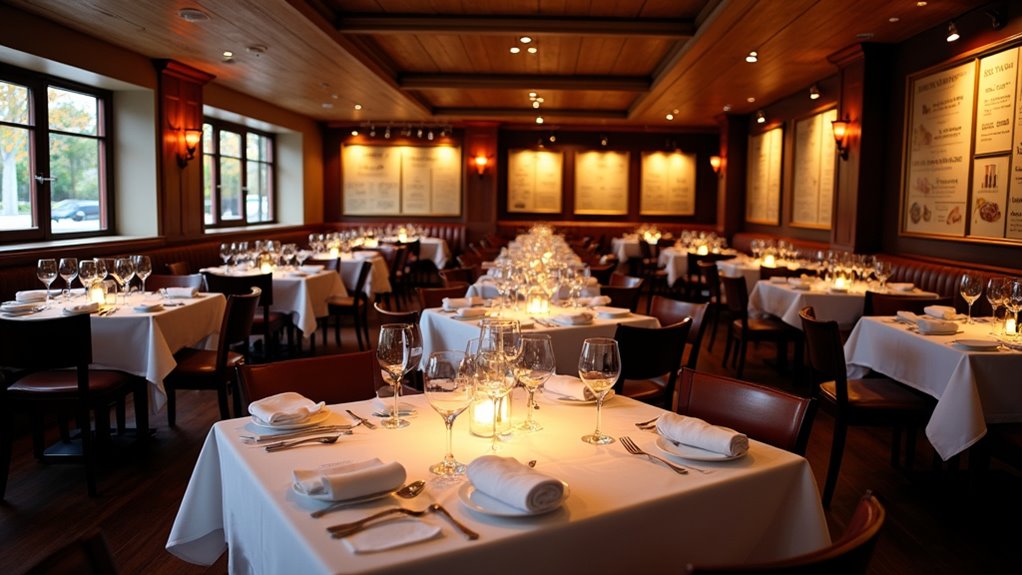
Effective strategic menu planning serves as a cornerstone for improving restaurant operations, as it not only addresses customer preferences but also aligns with the restaurant’s operational capabilities.
By implementing menu optimization strategies, the restaurant can analyze customer demographics and preferences to tailor dish complexity and portion sizes, while also accommodating dietary restrictions. This customer preference analysis aids in refining offerings, ensuring alignment with the restaurant’s concept and brand identity.
Limiting menu items accelerates decision-making for customers, reduces complexity, and enhances food quality. Seasonal and versatile ingredients optimize freshness and minimize waste, while operational feasibility ensures efficient preparation.
Innovative Space Utilization Approaches
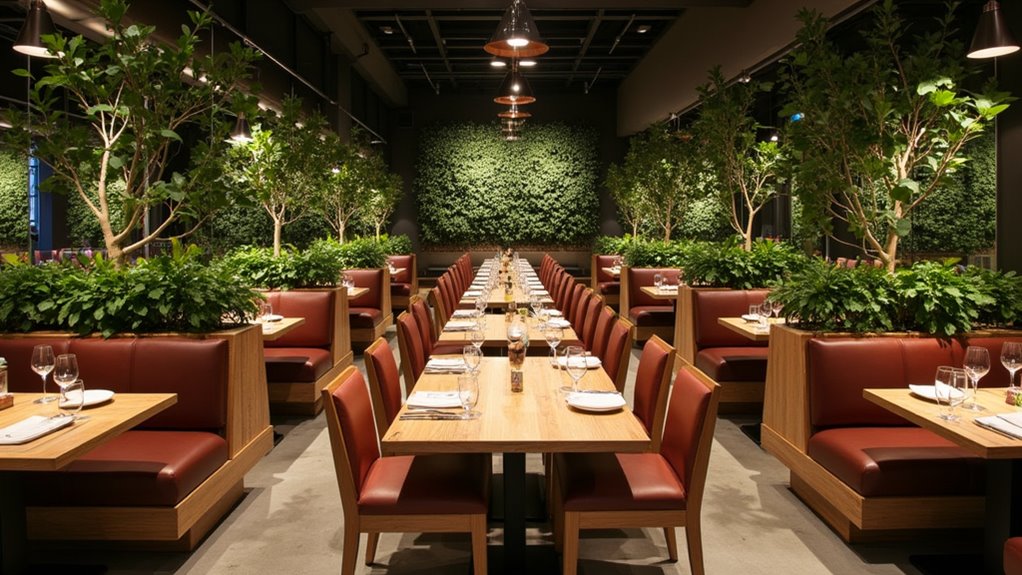
Innovative space utilization approaches focus on maximizing available areas while ensuring comfort and functionality.
- Multi-functional furniture allows for adaptability, using tables and chairs that can be reconfigured.
- Creative zoning employs distinct pathways and flexible partitions to define dining and waiting spaces.
- Vertical storage solutions optimize underutilized areas, keeping surfaces clear and facilitating smooth operations. Additionally, utilizing custom handmade dining tables can not only enhance the restaurant’s aesthetic but also provide the durability and adaptability needed for various dining arrangements.
Articles on the same topic:
-
Top 10 Dining Tables in Dubai for All Styles
-
7 Best Commercial Dining Tables and Chairs for Your Business
-
Top 3 Best Selling Dining Tables for 2025
-
Top 3 Brown Jordan Dining Tables for Your Outdoor Area
-
Top 3 Lexington Furniture Dining Tables for Your Home
-
7 Stunning Rustic Log Dining Room Tables for Your Home

